- Home
- Barbara Ehrenreich
Witches, Midwives, and Nurses
Witches, Midwives, and Nurses Read online
Table of Contents
Title Page
Introduction
Introduction to the First Edition
Witchcraft and Medicine in the Middle Ages
THE WITCH CRAZE
THE CRIMES OF WITCHES
WITCHES AS HEALERS
THE RISE OF THE EUROPEAN MEDICAL PROFESSION
THE SUPPRESSION OF WOMEN HEALERS
THE AFTERMATH
Women and the Rise of the American Medical Profession
ENTER THE DOCTOR
THE POPULAR HEALTH MOVEMENT
DOCTORS ON THE OFFENSIVE
PROFESSIONAL VICTORY
OUTLAWING THE MIDWIVES
THE LADY WITH THE LAMP
THE DOCTOR NEEDS A NURSE
Conclusion
Bibliography
NOTES
Copyright Page
HIS OWN WHERE
June Jordan
Introduced by Sapphire
WOMEN WHO KILL
Ann Jones
With a new introduction by the author
Great feminist books of the past fifty years don’t fade away.
They become Contemporary Classics.
Introduction to the Second Edition: The Backstory
WITHES, MIXWIVES & NURSES (WMN) IS A DOCUMENT from the second wave of feminism in the United States. Rereading it forty years later, we find it startling in its assertiveness and sweep and, for the most part, surprisingly accurate, given the paucity of materials we originally had to work with. At the same time, we also cringe a little at what read now like overstatements and overly militant ways of stating things. A lot has changed in forty years, both historically and in our approach to scholarship, so we have to remind ourselves that WMN was written in a blaze of anger and indignation. If some of the sources of our anger now seem quaint, this is only because of works like WMN and the movement it came out of.
By the early 1970s feminists were becoming aware of a variety of ways women were abused or treated unjustly by the medical system. As health care professionals, women were largely confined to subordinate roles as nurses and aides. As consumers of care, we found ourselves subject to both insensitive and hazardous treatment: unnecessary hysterectomies, over-medicated childbirth, insufficiently tested contraceptives, involuntary sterilizations, and the almost universal condescension of male doctors.
We were not supposed to know anything about our own bodies or to participate in decision-making about our own care. As girls, the women of our generation had grown up thinking of their reproductive organs as the unmentionable region “down there.” In the Ladies’ Home Journal, which many of our mothers read, the medical advice column was entitled “Tell Me, Doctor.” Women who asked too many questions or insisted, for example, on “natural” childbirth, frequently found themselves labeled, right in their medical records, as uncooperative or neurotic. Serious complaints were likely to be dismissed as “psychosomatic” and attributed to women’s assumed suggestibility. In the standard surgical protocol for breast cancer treatment, the patient was biopsied and then, if the result was positive, rushed into a radical mastectomy without ever being wakened from anesthesia to discuss her options.
One of our first projects in the emerging “women’s health movement” was to confront women’s ignorance of their own bodies. In Boston, a group of feminists had launched a series of “Know Your Body” courses aimed at the general public—the core of which became the groundbreaking book Our Bodies, Ourselves in 1970—and we helped put together a similar course in New York City. A small group of us got together and studied medical textbooks to prepare presentations on such topics as the menstrual cycle, pregnancy, and menopause. Today of course, anyone can learn about these things in high school courses, by reading women’s magazines, or just by googling. But at the time, women packed our evening classes, eager for whatever information we had to offer.
We were beginning to suspect that women had not always, in all circumstances, been so disempowered with respect to their own bodies and care. After all, medical technology and the medical profession that monopolized it were relatively recent historical developments, and yet somehow our female ancestors had, however imperfectly, negotiated the challenges of the female life cycle. Having met as teachers at a new branch of the State University of New York, the College at Old Westbury—which was devoted at the time to “nontraditional” students, usually in their twenties or older, for the most part black and Hispanic—we had an opportunity to satisfy our curiosity. The campus was then a hotbed of political debate over class, race, gender, and “identity politics,” with Florence Howe, who went on to launch the Feminist Press, working to develop what was one of the first women’s studies programs in the nation. Encouraged by her and other colleagues, we created a course on women’s health, which gave us an excuse to read up on the history of women and medicine.
There was not a lot to read at the time, the entire genre of books on “Women and . . .” having yet to be invented. Sometimes, in conventional histories of American medicine, we found tantalizing references to a time when women predominated as healers—but only as an indication of how “primitive” American medicine had been before the rise of the modern medical profession. What kept us going was the powerful reinforcement we were getting from our students, many of them practical nurses seeking RN degrees, who often brought with them memories and experiences of female healing traditions: we had midwives from the Caribbean, baffled by the then near nonexistence of midwifery in this country, women from European immigrant backgrounds who could recall grandmothers who practiced lay healing arts, and African Americans who carried memories of an autonomous black midwifery tradition in the American south.
Sometime in 1972—and we are both hazy on exactly when—we were invited to attend a small conference on women’s health held in rural Pennsylvania. This, it seemed, was our chance to test our emerging hypotheses on an audience of activists and a few fledgling scholars. We no longer possess the mimeographed outline of our findings that we took to the conference, but the central idea was that the medical profession as we knew it (still over 90 percent male) had replaced and driven out a much older tradition of female lay healing, including both midwifery and a range of healing skills, while closing medical education to women. In other words, the ignorance and disempowerment of women that we confronted in the 1970s were not longstanding conditions, but were the result of a prolonged power struggle that had taken place in America in the early nineteenth century, well before the rise of scientific medicine. We traced a similar power struggle in Europe back to the early modern era and, inspired in part by the wonderfully iconoclastic Thomas Szasz, we looked at how female lay healers of the same era were frequently targeted as “witches.”
The response to our presentation was sufficiently enthusiastic to warrant some sort of publication. But what? Neither of us had any access to the “mainstream” media. Nor were we interested in seeking a book contract. We wanted to publish our findings in a form that would be cheap, accessible, and engaging for exactly the kind of women who had been our students at the College at Old Westbury, and this meant neither a book nor a magazine article. The decision we made, which now seems to us somewhat extraordinary, was to self-publish our results in booklet form. By self-publishing, we maintained control over the content, including the choice of illustrations and we had an inexpensive product that could easily be passed from hand to hand. We called our little vanity press Glass Mountain Pamphlets, referring to an obstacle—like sexism—that we might not yet be able to smash but could at least see through. Its headquarters was the house we shared with three other adults and Barbara’s children.
The pamphlet was an instant su
ccess, at least as what the Village Voice called an “underground best-seller.” Word of it spread through networks of women’s groups as well as the through the counter-cultural underground newspapers of the time. Soon we found ourselves overwhelmed by the job of fulfilling orders—which we’d been shipping off in Pampers boxes generated by Barbara’s infant son—and gratefully accepted the newly founded Feminist Press’s offer to take over distribution. Eventually, WMN was translated into French, Spanish, German, Hebrew, Japanese, and Danish, and distributed in the UK. In 1993, one of us was invited to give a lecture tour in India, in part on the basis of the booklet’s popularity there. We felt vindicated in our decision to self-publish as a booklet, which, according to the accounts of readers, was indeed being passed among hospital nurses and was to be found in the many women’s bookstores and women’s health clinics that sprang up in those times. In 1973, the Feminist Press also published a ninety-six page companion booklet, Complaints and Disorders: The Sexual Politics of Sickness, which describes the effects of solely male-defined medical expertise on nineteenth- and twentieth-century women.
Sometimes, when we consider the vast amounts of relevant scholarly research that has become available since the 1970s, we wish we could be starting this project all over again (although that would be impossible, since some of that new research was inspired in part by WMN!) There is now a wealth of information about women as lay healers, midwives, and “doctresses” in early America and their subsequent exclusion from formal medical education in the nineteenth and twentieth centuries. If anything, even more information has become available about women as lay healers in early modern Europe, and their fates in the witch persecutions of the time—enough to tempt us into what could be many rewarding years of study. Much of this work bolsters and fleshes out our assertions in WMN, but some of it requires that we update and correct the original text.
First, on the matter of the number of women killed as witches, we used the estimates available to us at the time—scholars accepted figures of one million or even much higher. Although the body count will never be exact, historian John Demos writes that recent studies yield estimates that “fall in a range of “50,000 to 100,000.” Demos adds that, “These, in turn, were just a fraction of a much larger number of suspects. . . .”1
Second, we should clarify the role of the European medical profession relative to church and state. Witch trials represented extraordinary cooperation (and sometimes conflict) among all the dominant institutions, including both the legal and medical professions, which were heavily dependent on approval from the highest authorities. It was the medical profession that provided the courts with expert testimony: for example, Paulus Zacchias, the personal physician to two seventeenth-century Popes, authored a seven-volume treatise called Medico-Legal Questions to demonstrate “where medical knowledge could inform Canon Law on such issues as . . . the causes of foetal death, types of madness, poisoning, impotence, malingering, torture, [and] witchcraft . . .”2
Physicians benefited from the suppression of their competition: in the European cities where they congregated, they practiced in a market filled with lay healers and empirics. In London, in 1600, there were fifty physicians affiliated with the College of Physicians (a stronghold of Galenic medicine), outnumbered by some 250 mainly unlicensed practitioners (not including surgeons, apothecaries, midwives, and nurses) who a made a living.3 In 1581, the College of Physicians, which claimed the right to regulate medical practice in London, attempted to prevent a lay healer named Margaret Kennix from practicing—but Queen Elizabeth had intervened, decreeing that “the poore woman should be permitted by you quietly to practice and mynister to the curing of diseases and woundes, by the means of certain Simples [herbal remedies] in the applying wherof it seemth God hath given her an especial knowledge, to the benefit of the poorer sort. . . .”4 Such protection for her favored few was not to last after Elizabeth’s death in 1602.
We stand by our assertion that male physicians were both more dangerous and less effective than female lay healers. Francis Bacon (1561-1626) himself a scientific originator, thought that “empirics and old women” were “more happy many times in their cures than learned physicians.” The conservative philosopher Thomas Hobbes (1588-1679) concluded that he would “rather have the advice or take physic from an experienced old woman that had been at many sick people’s bedsides, than from the learnedst but unexperienced physician.”5
Third, we made the assumption that witches may have met in “covens” or other organized groups, and we referred to Margaret Murray when we said that “some writers speculate that these may have been occasions for pagan religious worship.” Murray’s research has since been discredited, and today most scholars seem to agree that the beliefs of women who were executed as witches cannot be differentiated from those of the rest of the population, and most were avowedly Christian. Some pagan religions or remnants did survive in places but the connection between this and women accused of witchcraft remains unclear.
Another point worth revisiting concerns the religious wars in the background of the witch hunts. We wrote: “. . . witch-healer’s methods were as great a threat (to the Catholic Church, if not the Protestant) as her results, for the witch was an empiricist . . .” We can no more do justice here to the conflicts of the Reformation and Counter-Reformation than we could in a short booklet. But it should be noted that while Protestants fought the Roman Catholic Church, they tortured and executed witches too.
But if we do stand corrected on these points, a few scholars, it seems to us, have gone too far in the other direction, sometimes with a view to discrediting WMN. For example, in 1990, our work was described as “trail-blazing” by an Oxford-based scholar, David Harley—but not in a good way.6 While agreeing that witches were often folk healers, he criticized us, based on a survey of convictions in England, Scotland, and New England, (data which was not available when we wrote) for exaggerating the proportion of midwives among convicted witches, saying we had maligned midwives and created “a multitude of imaginary martyrs for the modern women’s health movement.” Others, like art historian Jane Davidson of the University of Nevada, seemed to echo him without adding any new data to the argument and began to refer, even less plausibly, to “the myth of the persecuted witch-healer.” 7
It is true that the only primary source available to us at the time was the fifteenth-century witch-hunters’ guidebook, The Malleus Malificarum, which proclaimed that “No one does more harm to the Catholic Church than midwives.”8 Even now, with all the archival data that has become available, it’s impossible for scholars to offer statistically firm generalizations about the occupations of women accused of witchcraft: usually, the convicted person’s occupation was not recorded.
Yet the association that witch hunters made between witches and midwives in Europe is inescapable. Based on archival research in Germany, Lyndal Roper documents several examples, finding for instance, in 1590, in the town of Nördlingin, that one midwife, Barbara Lierheimer, had angrily let it be known that the executioner “had ruined her livelihood by putting it about that she was a witch.” Soon she was arrested, and after many contradictory denials and confessions, finally tortured to death. In Würtzburg in 1627, Roper tells us that a “crafty midwife” was listed among those condemned, and the scribe has added in the margin the comment, “The whole business comes from her.” Much later in the seventeenth century, in Augsberg, Roper found the pastor at Holy Cross Church had “no compunctions about saying the local midwife was a witch, and he flatly refused to baptize any children she brought to the altar.”9
Whatever the number of convicted midwives, few historians would dispute the prevalence of lay healers among those accused of witchcraft. According to historian Brian P. Levack, “studies of witchcraft depositions in Switzerland, Austria, Schleswig-Holstein, England, Scotland, and New England reveal that many of those who were prosecuted for witchcraft were in fact wise-women.”He writes that it was their prominence as “cooks, hea
lers and midwives” that made women in general “vulnerable to the charge that they practiced harmful magic.”10
But “harmful magic” was not the only kind of accusation: as we pointed out in the pamphlet, the practice of healing or “white witchcraft” was itself a sign of being a follower of Satan. William Perkins (1558- 1602), an English Protestant minister and theologian, was one of the clergymen who introduced continental ideas of witchcraft into England and New England. He preached that in addition to “bad witches,” there were “good witches” who only cured the “hurts” that had been inflicted by “bad witches,” explaining: “. . . of the two the more horrible and detestable monster is the good witch . . . which are better known than the bad, being commonly called wisemen or wisewomen. This will appear by experience in most places in this country.”11
In colonial New England, which we did not attempt to cover in WMN, recent scholarship has revealed much more about the relationship between healers and witch persecutions. According to David D. Hall, healers in seventeenth century New England seem to have been “especially vulnerable” to charges of witchcraft. Healing was considered suspicious because it “did not rely on confession of sin” to clergy, and disease was still thought to be caused by either God or the Devil. 12 In The Enemy Within, John Demos describes the profile of the typical woman tried for witchcraft in New England, writing that perhaps a quarter to a third of the suspect group was known for “making and administering special ‘remedies,’ providing expert forms of nursing, or serving in some regular way as midwives. A few were specifically described as ‘doctor women.’ . . . .The underlying linkage here is obvious enough; the ability to heal and the ability to harm seemed intimately related.” Demos speculates about the general effect of the persecutions: “Clearly, the wisest course in early modern community life—especially for a woman—was to blend in and not to seem too openly self-assertive. To be, or to behave, otherwise was to open oneself to suspicion of witchcraft.”13

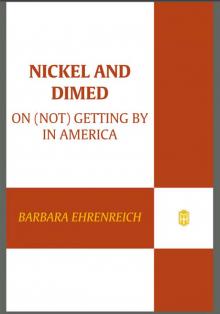 Nickel and Dimed: On (Not) Getting by in America
Nickel and Dimed: On (Not) Getting by in America Living With a Wild God
Living With a Wild God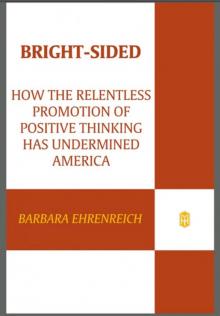 Bright-Sided
Bright-Sided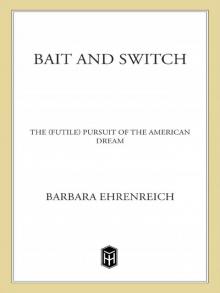 Bait and Switch: The (Futile) Pursuit of the American Dream
Bait and Switch: The (Futile) Pursuit of the American Dream Dancing in the Streets: A History of Collective Joy
Dancing in the Streets: A History of Collective Joy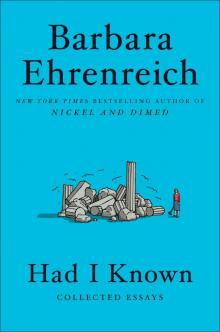 Had I Known
Had I Known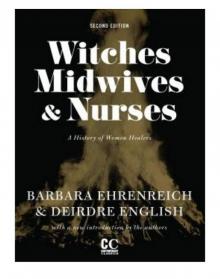 Witches, Midwives, and Nurses
Witches, Midwives, and Nurses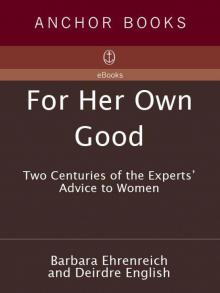 For Her Own Good: Two Centuries of the Experts Advice to Women
For Her Own Good: Two Centuries of the Experts Advice to Women Nickel and Dimed
Nickel and Dimed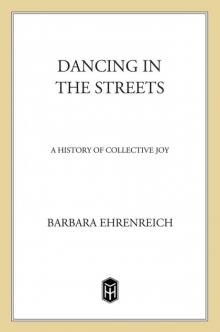 Dancing in the Streets
Dancing in the Streets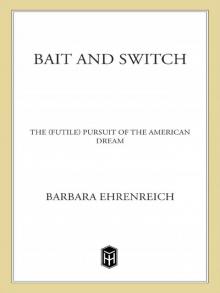 Bait and Switch
Bait and Switch